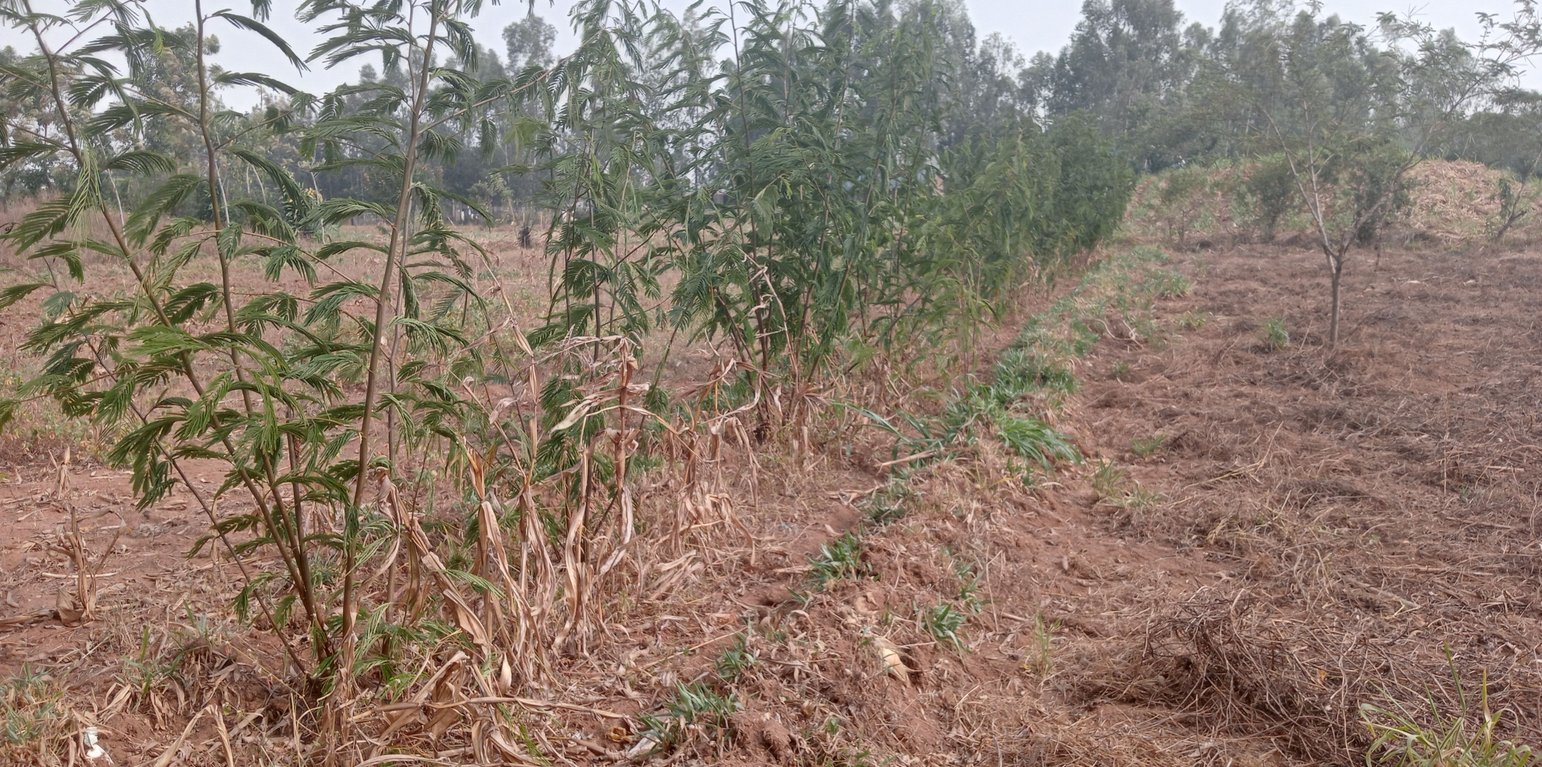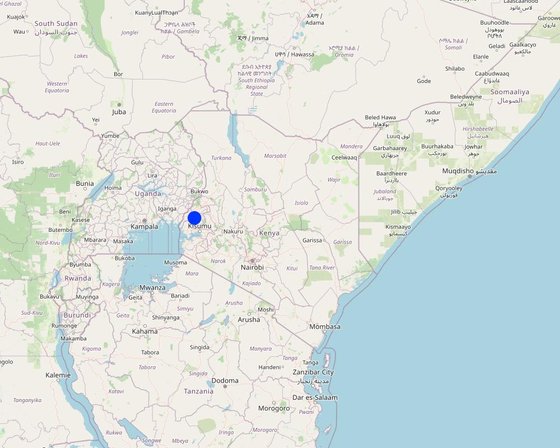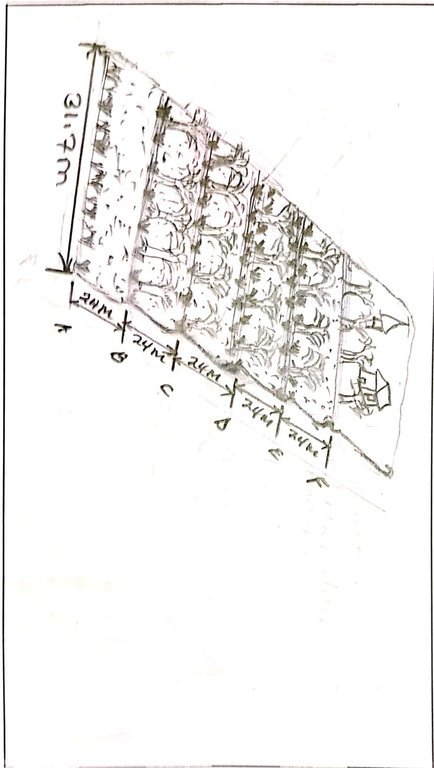



Vegetative cross-slope barriers are strips of perennial plants that are established along the contours of sloping lands. They act as soil and water conservation measures to reduce runoff velocity and consequently prevent soil loss. The strips are mostly between 0.3 m and 1.5 m wide and consist initially of one or two rows of plants. They slow down the speed of runoff during heavy rainfall. This facilitates infiltration, and eroded sediment in the runoff is trapped on the upslope side of the barriers. Hence, they contribute to the conservation of soil, water, and plant nutrients. The most used plants/ crops used in establishing vegetative cross-slope barriers are perennial erect grasses, including Brachiaria sp., napier grass (Pennisetum purpureum), and vetiver grass (Vetiver zizanioides). Depending on species (vetiver being an exception), vegetative cross-slope barriers can serve as important sources of fodder for livestock. Some farmers prefer to establish crops (e.g., bananas and pineapples) or trees and shrubs (e.g., (e.g., Calliandra calothyrus, Grevillea robusta or Sesbania sesban) as cross-slope barriers at appropriate spacing (depending on the tree/ shrub) to serve as windbreakers as well as providing additional measures to control soil erosion. Alternatively, these may be combined with grasses. These can also serve as important sources of food, fodder, fuel, and timber.
In establishing vegetative cross-slope barriers, the distance between the barriers is dictated by the slope of the land. The ProSoil project through Welthungerhilfe trained Community Resource Persons (CRPs) on how to survey contours using a line level. The CRPs by extension train farmers on how to measure slope for their fields and how to determine the distance between the barriers using a predetermined scale. Once established, minimal labour is required for maintenance. The main vegetation (grasses) must be harvested or cut back to a height of less than 0.5 m before planting a crop in the main field to prevent them from suppressing the crops through shading. The trees, and shrubs may need to be trimmed (coppiced) during the cropping period to allow adequate sunlight to reach the crops. The cut material can be collected and used as fodder or firewood as appropriate or be incorporated during land preparation, or during weeding as mulch.
Farmers like the technology because it contributes to soil, water, and nutrient conservation and it reduces the steepness of the slope as soil eroded from the upper part of the slope accumulates on the upslope side of the barrier resulting, eventually, in distinct terrace-like benches. As a result, farmers find it easier to cultivate on these terraces. Vegetative cross-slope barriers can be associated with retention ditches, especially where farmers find it important to harvest the water. They can also provide firewood and fodder, especially where palatable cut and carry varieties of grass are used.

Lugar: Khalaba Ward, Matungu Sub-county in Kakamega County, Kakamega County in western Kenya, Kenia
No. de sitios de Tecnología analizados: un solo sitio
Difusión de la Tecnología: distribuida parejamente sobre un área (0.003804 km²)
¿En un área de protección permanente?: No
Fecha de la implementación: 2019
Tipo de introducción


| Especies | Conteo |
| cattle - dairy and beef (e.g. zebu) | 3 |
| aves de corral | 10 |



| Especifique insumo | Unidad | Cantidad | Costos por unidad (KES) | Costos totales por insumo (KES) | % de los costos cubiertos por los usuarios de las tierras |
| Mano de obra | |||||
| Weeding | Man-days | 3,0 | 250,0 | 750,0 | 100,0 |
| Adding manure/ compost | Man-days | 2,0 | 250,0 | 500,0 | 100,0 |
| Equipo | |||||
| Hoe (jembe) for weeding | No. | 1,0 | 90,0 | 90,0 | 100,0 |
| Wheelbarrow for carrying manure/ compost | No. | 1,0 | 500,0 | 500,0 | 100,0 |
| Spade for scooping manure/ wheelbarrow | No. | 1,0 | 100,0 | 100,0 | 100,0 |
| Fertilizantes y biocidas | |||||
| Manure/ compost | Wheelbarrows | 20,0 | 50,0 | 1000,0 | 100,0 |
| Indique los costos totales para mantenecer la Tecnología | 2'940.0 | ||||
| Costos totales para mantener la Tecnología en USD | 23.67 | ||||
Cantidad antes de MST: 2
Cantidad luego de MST: 6
Quantity refers to the number of 90 Kg bags of maize produced per acre. Although vegetative cross-slope barriers reduced the available space for crops, other SLM technologies such as retention ditches and the use of compost contributed to the increase in the production. According to the farmer, the soil at the farm was highly eroded before the SLM technologies were introduced.
Not easy to quantify but according to the farmer, the crops are doing better compared to how they were before the cross-slope barriers were established.
the farmer estimates that the amount of napier grass harvested from the farm within a year has increased. Farmer not able to quantify.
Not easy to quantify but according to the farmer, napier grass is doing better compared to how it was before the cross-slope barriers were established.
Cantidad antes de MST: 4
Cantidad luego de MST: 7
Amount of milk produced by one cow during early lactation period.
Easy of working on less eroded soils. A farmer's estimate.
Cantidad antes de MST: 5000
Cantidad luego de MST: 0
Expenditure on fertilizer in KES. The farmer no longer uses fertilizer.
Cantidad antes de MST: 0
Cantidad luego de MST: 6000
The farmer earns income from selling napier grass - per year. This is based on the farmer's estimate.
The farmer considers the money earned from selling napier grass as an extra source of income.
Cantidad antes de MST: 2
Cantidad luego de MST: 0.5
Number of months in a year when there is total lack of food in the house, and the farmer has to buy all the food required in the house. Based on the farmer's estimate.
Level of knowledge in SLM/ land management. This is a farmer's estimate that she has increased her knowledge in SLM.
The farmer notes that the amount of water leaving the farm and silting other farms in the lower areas. has greatly reduced.
the farmer notes that the amount of silt deposited in the lower parts of the farm and in other farms on the lower side of the farm has reduced.
the farmer notes that the amount of soil trapped by the vegetative cross slope barriers is high and this leads to an increase in soil accummulation at the farm.
Amount of runoff leaving the farm with potential to cause soil erosion in neighbouring farms.